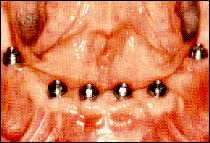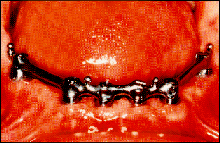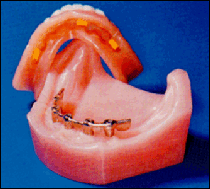
Dental Patient Education
|
Dental Implants Step 3 |
|
Stage 3: Restoration |
||||
|
|
||||
|
How are the new teeth created?
From this model, the prostheses (artificial replacement tooth or teeth) is created. To ensure the best possible fit, the dentist will need to see you several times. The fitting process can take a few months. During this time, you can continue to wear a denture, partial or false tooth. How are the new dentures made? To ensure the best possible fit, a trial set of teeth is set in wax for a fitting. Then the final prosthesis is made and fitted onto a cast metal framework, which may have artificial gum tissue added. A bridge can be constructed from porcelain or composite and screwed or cemented onto the abutment. When appropriate, a bar is made to connect two or more implants, with a clip within the denture to provide retention. What types of prostheses are available?A prosthesis can be removable or fixed, or a combination of both. Fixed means only the restorative dentist can take it out. A removable prosthesis often replaces a full set of teeth. It attaches firmly to the abutments with a retaining device but can be take out for ease of cleaning.
A fixed prosthesis can replace one (as shown on the first page of this FAQ), several or the full set of teeth. For several teeth, the entire metal frame must be carefully fitted to the mouth. For this reason, the fixed prosthesis may be worn during an adjustment period before it is permanently attached to the abutments. Once attached, the fixed prosthesis can only be removed by a dentist. Precautions after receiving the new teethYou should not eat hard or crunchy foods for the first few weeks after the prosthesis is installed. To avoid damaging the prosthesis, never chew on ice, pencils, pens, metal or other hard objects. Symptoms to report immediatelyCall your surgeon or dentist if:
|
||||
|
|
||||
| © Copyright 1996 - 2008 HIVdent.org. All Rights Reserved. | ||
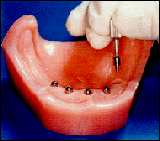 The healing abutments placed during the second stage are removed.
Your mouth will need to completely heal around your implants and abutments for
approximately one to two weeks.
The healing abutments placed during the second stage are removed.
Your mouth will need to completely heal around your implants and abutments for
approximately one to two weeks.
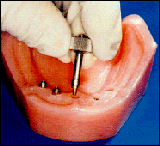 Afterwards, the final abutments are then placed on
the posts. The process to create your new teeth may now begin.
Afterwards, the final abutments are then placed on
the posts. The process to create your new teeth may now begin. 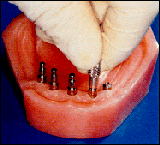 Impression posts are temporarily placed on the posts and the dentist takes
impressions (molds of your mouth) and bite registrations (imprints of how the jaws and
teeth fit together). They are used to fabricate a model of your jaw and any remaining
teeth a s well as the abutments themselves.
Impression posts are temporarily placed on the posts and the dentist takes
impressions (molds of your mouth) and bite registrations (imprints of how the jaws and
teeth fit together). They are used to fabricate a model of your jaw and any remaining
teeth a s well as the abutments themselves. 